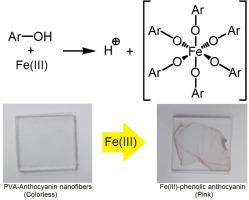Journal of Environmental Chemical Engineering ( IF 7.4 ) Pub Date : 2021-01-13 , DOI: 10.1016/j.jece.2021.105072 Mehrez E. El-Naggar , Mohamed H. El-Newehy , Ali Aldalbahi , Waheed M. Salem , Tawfik A. Khattab

|
An effective nanofibrous metallochromic sensor mat was developed. Electrospun nanofibers were generated from a solution of polyvinyl alcohol (PVA) as a host polymer and anthocyanin extract from red-cabbage as an active detection sites. Using PVA as a supramolecular hosting matrix and anthocyanin phenolic dye (AC) as a spectroscopic probe, a novel, simple, rapid, portable and colorimetric sensor was developed for ferric ions (Fe3+) in aqueous environments. Binding these toxic ferric cations causes an appreciable color change from colorless to pink as proved by the CIE Lab color parameters. The visible color variation was found to change proportionally depending on increasing the concentration of ferric ions. The naked-eye recognition of Fe3+ was rationalized on the basis of Fe(III)-phenolic anthocyanin complex formation. High Performance Liquid Chromatography Mass Spectrometry (HPLC-MS) was applied to characterize the anthocyanin extract. The surface morphology and structural characterization of the generated nanofibers were explored by scanning electron microscopy (SEM) and energy-dispersive X-ray analyzer (EDS). The generated electrospun PVA-AC nanofibrous film displayed an average diameter of 150–250 nm. They were firstly cross-linked using the vapors of glutaraldehyde to turn them into water-insoluble nanofibers. Both selectivity and detection limit have been also studied. The anthocyanin-containing nanofibers display an excellent simplicity and reusability with a limit of detection in the range between 1 and 350 mg/L. The detection limit was monitored as low as 1 mg/L. PVA-AC showed excellent selectivity compared to other transition metal ions, including Cu2+, Mg2+, Hg2+, Co2+, Ba2+, Zn2+, Ni2+, Cr3+, Al3+, Ca2+, K+, Na+, Cd2+ and Mn2+. The best optimized conditions for the detection of Fe3+ was achieved in a pH range from 3.75 to 6.0. The proposed assay has the advantage of rapidity, simplicity, facile fabrication, low cost, environmental safety and easy to operate compared to other detection techniques.
中文翻译:

将红甘蓝中的花色苷提取物固定到电纺聚乙烯醇纳米纤维中,用于比色选择性检测三价铁离子
开发了一种有效的纳米纤维金属致变色传感器垫。静电纺丝纳米纤维由聚乙烯醇(PVA)作为主体聚合物的溶液和红卷心菜的花色苷提取物作为活性检测位点产生。使用PVA作为超分子宿主基质,并使用花青素酚醛染料(AC)作为光谱探针,开发了一种新颖,简单,快速,便携式和比色传感器,用于水性环境中的铁离子(Fe 3+)。结合这些有毒的三价阳离子会导致明显的颜色变化,从无色变为粉红色,这由CIE Lab颜色参数证明。发现可见的颜色变化根据增加的铁离子浓度成比例地变化。Fe 3+的肉眼识别基于Fe(III)-酚类花色苷配合物的形成合理化。高效液相色谱质谱法(HPLC-MS)用于表征花色苷提取物。通过扫描电子显微镜(SEM)和能量色散X射线分析仪(EDS)探索了生成的纳米纤维的表面形态和结构特征。生成的电纺PVA-AC纳米纤维薄膜的平均直径为150-250 nm。首先使用戊二醛蒸汽将它们交联,将其转变为水不溶性纳米纤维。还研究了选择性和检测限。含花青素的纳米纤维显示出极好的简单性和可重复使用性,其检测极限在1至350 mg / L之间。监测极限低至1 mg / L。2+,Mg 2 +,Hg 2 +,Co 2 +,Ba 2 +,Zn 2 +,Ni 2 +,Cr 3+,Al 3+,Ca 2 +,K +,Na +,Cd 2+和Mn 2+。在3.75至6.0的pH范围内实现了检测Fe 3+的最佳最佳条件。与其他检测技术相比,所提出的测定法具有快速,简单,易于制造,成本低,环境安全且易于操作的优点。











































 京公网安备 11010802027423号
京公网安备 11010802027423号